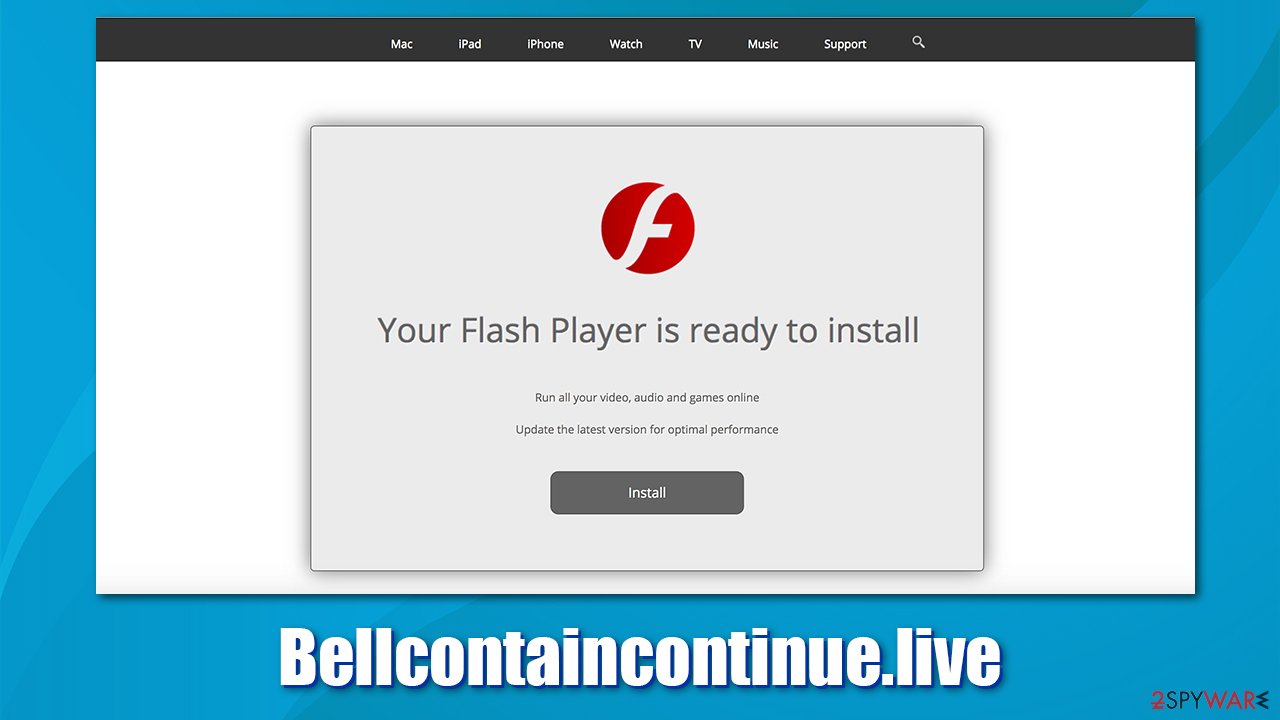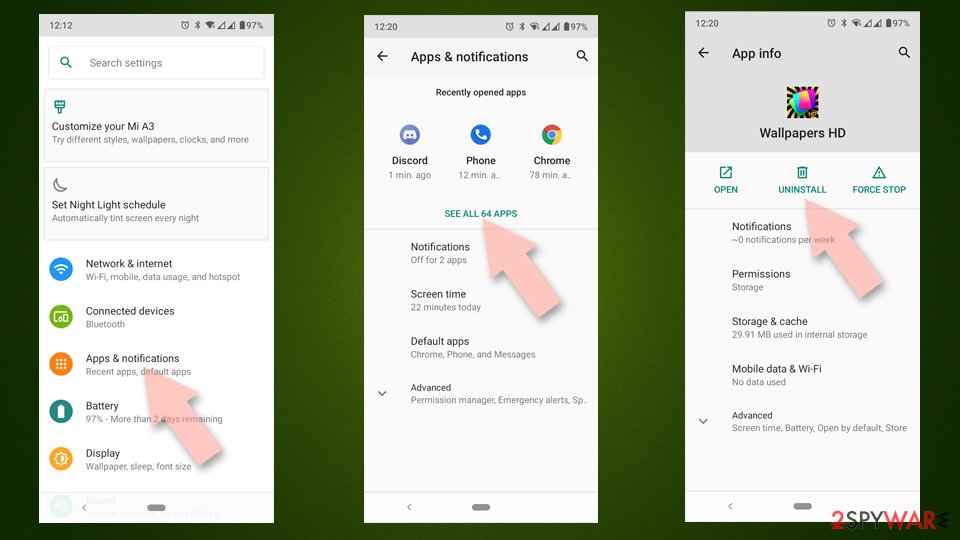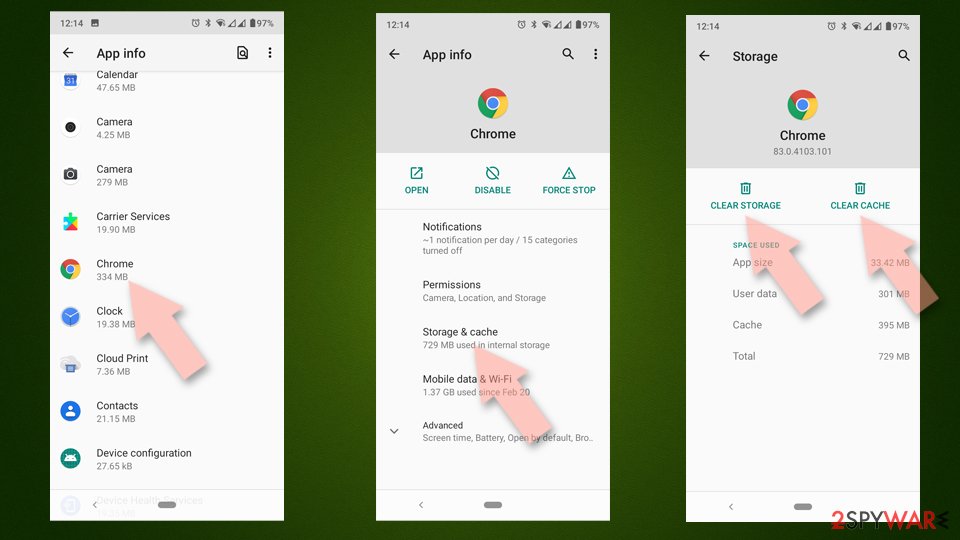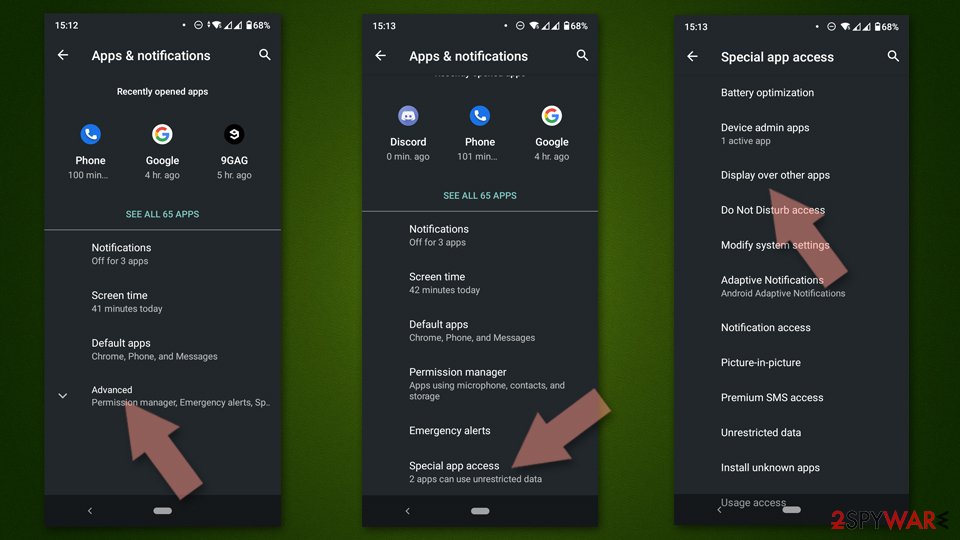Bellcontaincontinue ads (Virus Removal Guide) - Free Instructions
Bellcontaincontinue ads Removal Guide
What is Bellcontaincontinue ads?
Bellcontaincontinue ads – a set of shady websites that promote fake surveys and display unwanted ads

Bellcontaincontinue is a name of a website chain that shows tons of advertisements and tries to trick its visitors into subscribing to push notifications in order to deliver even more ads. Users can encounter variations of it, including Bellcontaincontinue-8.live, Bellcontaincontinue-15.live, and so on. Withhold from visiting similar sites and clicking any to their ads.
These websites are operational for a short time, as they are usually taken down. Before that, however, visitors might be tricked into filling fake surveys or visiting scam sites, as well as download malicious software. People do not usually visit Bellcontaincontinue ads websites on purpose. They are redirected to these sites when they press deceptive ads on shady websites or when their devices are infected with adware.
Due to annoying ads that might lead to further infecting computers (Windows and Mac) or cell phones (Android, iOS), some people might call it the Bellcontaincontinue virus. If you see suspicious ads on your device and your web browser is acting abnormally, you should check the free solutions for this problem below.
| name | Bellcontaincontinue ads |
|---|---|
| Type | Adware, redirect |
| Website variations |
|
| Symptoms | Redirects to suspicious sites, an abnormal amount of pop-up and other kinds of ads, slower device performance |
| Risks | Deceptive ads might lead to high-risk portals where users might get tricked into submitting their personal info or get infected with PUPs or malware |
| Distribution | Freeware/software bundling, deceptive ads |
| Removal | The best way to take care of any computer infections is by removing them with trustworthy anti-malware tools |
| System fix | To restore broken system files and clean up your devices, like tracking cookies, etc., users are advised to use the FortectIntego system tune-up tool |
Bellcontaincontinue ads aren't like the ads you see when visiting your favorite sites. These pop-ups pose a real threat to your privacy and security. If any of these ads are clicked, whether intentionally or accidentally, users might get redirected to sites with questionable content, including:
- adult websites,
- online gambling,
- fake surveys,
- sites that would push various potentially unwanted programs,[1]
- pages with fake installers/updaters, etc.
Any of Bellcontaincontinue pop-up ads or redirects could bring harm. Moreover, not only pop-ups but also coupons, banners, promos, and other kinds of ads might be displayed. If you're redirected to this site, please refrain from clicking on anything, no matter how fascinating it might look.
Close the tab and perform a full system scan with trustworthy anti-malware tools to remove Bellcontaincontinue ads from the affected device. If you don't own one, we recommend acquiring either SpyHunter 5Combo Cleaner or Malwarebytes. Either of them will prevent you from visiting high-risk sites by blocking them and protect you from malware infections.

Although to complete Bellcontaincontinue ads removal, users will have to alter some browser settings. For novice users, we provide detailed instructions below this article. When all computer infections are taken care of, experts[2] recommend performing a system repair with the FortectIntego app to ensure stable system performance.
Watch out for additional apps in software bundles to avoid PUPs
Creators of potentially unwanted programs monetize by redirecting users to affiliated sites and luring users to click on displayed advertisements. Browser hijackers, adware, and other junkware are distributed using a sneaky technique called software bundling.
When people download software bundles, there usually are more than two apps offered. All the trickery is that all apps are preselected for installation, so as soon as a user presses Recommended/Standard mode, all programs from the bundle get installed.
It's easy to evade PUPs that are spread by this technique – users have to pay attention to what's installed from these packs. Choose Advanced/Custom mode and deselect all pre-ticked boxes from the offers you're not interested in. To avoid bundles, users should download software only from legitimate vendors, but that doesn't guarantee that some of them won't be using bundling.
Easy Bellcontaincontinue ads removal guide from all types of browsers
All types of devices and web browsers, including Safari, Chrome, Firefox, and so on, can get infected with the Bellcontaincontinue virus. If you're constantly redirected to this page, that means that your machine is infected with adware.

You came to the right place to find out how to remove Bellcontaincontinue ads. First off, you'll need to scan your device with anti-malware software. Eliminate any files that the security tool recommends. If such a tool isn't present or you think it's too weak, then acquire a professional anti-malware solution that will protect you from various PUPs and malware.[3]
Then refer to our manual Bellcontaincontinue ads removal instructions posted below this article. If you follow them step-by-step, you'll get rid of the irritating pop-ups once and for all. Afterward, we suggest users use system repair tools to fix any broken system files, registry values and restore overall system health.
Getting rid of Bellcontaincontinue ads. Follow these steps
Uninstall from Android
If you encounter Bellcontaincontinue redirects or ads on Android device, follow these steps:
Uninstall unwanted programs from Android device:
- Go to Settings -> Apps/Applications.
- Expand the full list of the installed apps.
- Scroll through the list and tap on a suspicious application once.
- Tap on it and select Uninstall.

- Reboot the device.
Clear Storage and data files on Android from Google Chrome or other apps:
- Go to Settings > Apps/Applications.
- Expand the full list of the installed apps.
- Tap on Chrome and select Storage & cache.
- Clear storage and clear cache of the app.

If you are seeing ads on top of other apps but are not sure what is causing it, perform the following steps:
- Go to Apps/Applications.
- Tap Advanced.
- Select Special App access.
- Tap on Display over other apps.

- Eliminate apps with these access rights enabled.
Stop browser notifications
After being redirected to a suspicious website, you might be tricked into subscribing to notifications that later produce unwanted pop-ups. Proceed with the following instructions:
Remove unwanted notifications from Google Chrome (desktop):
- Open Google Chrome browser and go to Menu > Settings.
- Scroll down and click on Advanced.
- Locate Privacy and security section and pick Site Settings > Notifications.

- Look at the Allow section and look for a suspicious URL.
- Click the three vertical dots next to it and pick Block. This should remove unwanted notifications from Google Chrome.

Remove unwanted notifications from Google Chrome (Android):
- Open Google Chrome and tap on Settings (three vertical dots).
- Select Notifications.
- Scroll down to the Sites section.
- Locate the unwanted URL and toggle the button to the left (Off setting).

Remove unwanted notifications from Mozilla Firefox:
- Open Mozilla Firefox and go to Menu > Options.
- Click on Privacy & Security section.
- Under Permissions, you should be able to see Notifications. Click the Settings button next to it.

- In the Settings – Notification Permissions window, click on the drop-down menu by the URL in question.
- Select Block and then click on Save Changes. This should remove unwanted notifications from Mozilla Firefox.

Remove unwanted notifications from Safari:
- Click on Safari > Preferences…
- Go to the Websites tab and, under General, select Notifications.
- Select the web address in question, click the drop-down menu and select Deny.

Remove unwanted notifications from MS Edge:
- Open Microsoft Edge, and click the Settings and more button (three horizontal dots) at the top-right of the window.
- Select Settings and then go to Advanced.
- Under Website permissions, pick Manage permissions and select the URL in question.

- Toggle the switch to the left to turn notifications off on Microsoft Edge.

Remove unwanted notifications from MS Edge (Chromium):
- Open Microsoft Edge, and go to Settings.
- Select Site permissions.
- Go to Notifications on the right.
- Under Allow, you will find the unwanted entry.
- Click on More actions and select Block.

Remove unwanted notifications from Internet Explorer:
- Open Internet Explorer, and click on the Gear icon at the top-right of the window.
- Select Internet options and go to the Privacy tab.
- In the Pop-up Blocker section, click on Settings.
- Locate web address in question under Allowed sites and pick Remove.

Uninstall from Windows
Instructions for Windows 10/8 machines:
- Enter Control Panel into Windows search box and hit Enter or click on the search result.
- Under Programs, select Uninstall a program.

- From the list, find the entry of the suspicious program.
- Right-click on the application and select Uninstall.
- If User Account Control shows up, click Yes.
- Wait till uninstallation process is complete and click OK.

If you are Windows 7/XP user, proceed with the following instructions:
- Click on Windows Start > Control Panel located on the right pane (if you are Windows XP user, click on Add/Remove Programs).
- In Control Panel, select Programs > Uninstall a program.

- Pick the unwanted application by clicking on it once.
- At the top, click Uninstall/Change.
- In the confirmation prompt, pick Yes.
- Click OK once the removal process is finished.
Delete from macOS
Remove items from Applications folder:
- From the menu bar, select Go > Applications.
- In the Applications folder, look for all related entries.
- Click on the app and drag it to Trash (or right-click and pick Move to Trash)

To fully remove an unwanted app, you need to access Application Support, LaunchAgents, and LaunchDaemons folders and delete relevant files:
- Select Go > Go to Folder.
- Enter /Library/Application Support and click Go or press Enter.
- In the Application Support folder, look for any dubious entries and then delete them.
- Now enter /Library/LaunchAgents and /Library/LaunchDaemons folders the same way and terminate all the related .plist files.

Remove from Microsoft Edge
Delete unwanted extensions from MS Edge:
- Select Menu (three horizontal dots at the top-right of the browser window) and pick Extensions.
- From the list, pick the extension and click on the Gear icon.
- Click on Uninstall at the bottom.

Clear cookies and other browser data:
- Click on the Menu (three horizontal dots at the top-right of the browser window) and select Privacy & security.
- Under Clear browsing data, pick Choose what to clear.
- Select everything (apart from passwords, although you might want to include Media licenses as well, if applicable) and click on Clear.

Restore new tab and homepage settings:
- Click the menu icon and choose Settings.
- Then find On startup section.
- Click Disable if you found any suspicious domain.
Reset MS Edge if the above steps did not work:
- Press on Ctrl + Shift + Esc to open Task Manager.
- Click on More details arrow at the bottom of the window.
- Select Details tab.
- Now scroll down and locate every entry with Microsoft Edge name in it. Right-click on each of them and select End Task to stop MS Edge from running.

If this solution failed to help you, you need to use an advanced Edge reset method. Note that you need to backup your data before proceeding.
- Find the following folder on your computer: C:\\Users\\%username%\\AppData\\Local\\Packages\\Microsoft.MicrosoftEdge_8wekyb3d8bbwe.
- Press Ctrl + A on your keyboard to select all folders.
- Right-click on them and pick Delete

- Now right-click on the Start button and pick Windows PowerShell (Admin).
- When the new window opens, copy and paste the following command, and then press Enter:
Get-AppXPackage -AllUsers -Name Microsoft.MicrosoftEdge | Foreach {Add-AppxPackage -DisableDevelopmentMode -Register “$($_.InstallLocation)\\AppXManifest.xml” -Verbose

Instructions for Chromium-based Edge
Delete extensions from MS Edge (Chromium):
- Open Edge and click select Settings > Extensions.
- Delete unwanted extensions by clicking Remove.

Clear cache and site data:
- Click on Menu and go to Settings.
- Select Privacy, search and services.
- Under Clear browsing data, pick Choose what to clear.
- Under Time range, pick All time.
- Select Clear now.

Reset Chromium-based MS Edge:
- Click on Menu and select Settings.
- On the left side, pick Reset settings.
- Select Restore settings to their default values.
- Confirm with Reset.

Remove from Mozilla Firefox (FF)
Remove dangerous extensions:
- Open Mozilla Firefox browser and click on the Menu (three horizontal lines at the top-right of the window).
- Select Add-ons.
- In here, select unwanted plugin and click Remove.

Reset the homepage:
- Click three horizontal lines at the top right corner to open the menu.
- Choose Options.
- Under Home options, enter your preferred site that will open every time you newly open the Mozilla Firefox.
Clear cookies and site data:
- Click Menu and pick Settings.
- Go to Privacy & Security section.
- Scroll down to locate Cookies and Site Data.
- Click on Clear Data…
- Select Cookies and Site Data, as well as Cached Web Content and press Clear.

Reset Mozilla Firefox
If clearing the browser as explained above did not help, reset Mozilla Firefox:
- Open Mozilla Firefox browser and click the Menu.
- Go to Help and then choose Troubleshooting Information.

- Under Give Firefox a tune up section, click on Refresh Firefox…
- Once the pop-up shows up, confirm the action by pressing on Refresh Firefox.

Remove from Google Chrome
Delete malicious extensions from Google Chrome:
- Open Google Chrome, click on the Menu (three vertical dots at the top-right corner) and select More tools > Extensions.
- In the newly opened window, you will see all the installed extensions. Uninstall all the suspicious plugins that might be related to the unwanted program by clicking Remove.

Clear cache and web data from Chrome:
- Click on Menu and pick Settings.
- Under Privacy and security, select Clear browsing data.
- Select Browsing history, Cookies and other site data, as well as Cached images and files.
- Click Clear data.

Change your homepage:
- Click menu and choose Settings.
- Look for a suspicious site in the On startup section.
- Click on Open a specific or set of pages and click on three dots to find the Remove option.
Reset Google Chrome:
If the previous methods did not help you, reset Google Chrome to eliminate all the unwanted components:
- Click on Menu and select Settings.
- In the Settings, scroll down and click Advanced.
- Scroll down and locate Reset and clean up section.
- Now click Restore settings to their original defaults.
- Confirm with Reset settings.

Delete from Safari
Remove unwanted extensions from Safari:
- Click Safari > Preferences…
- In the new window, pick Extensions.
- Select the unwanted extension and select Uninstall.

Clear cookies and other website data from Safari:
- Click Safari > Clear History…
- From the drop-down menu under Clear, pick all history.
- Confirm with Clear History.

Reset Safari if the above-mentioned steps did not help you:
- Click Safari > Preferences…
- Go to Advanced tab.
- Tick the Show Develop menu in menu bar.
- From the menu bar, click Develop, and then select Empty Caches.

How to prevent from getting adware
Access your website securely from any location
When you work on the domain, site, blog, or different project that requires constant management, content creation, or coding, you may need to connect to the server and content management service more often. The best solution for creating a tighter network could be a dedicated/fixed IP address.
If you make your IP address static and set to your device, you can connect to the CMS from any location and do not create any additional issues for the server or network manager that needs to monitor connections and activities. VPN software providers like Private Internet Access can help you with such settings and offer the option to control the online reputation and manage projects easily from any part of the world.
Recover files after data-affecting malware attacks
While much of the data can be accidentally deleted due to various reasons, malware is one of the main culprits that can cause loss of pictures, documents, videos, and other important files. More serious malware infections lead to significant data loss when your documents, system files, and images get encrypted. In particular, ransomware is is a type of malware that focuses on such functions, so your files become useless without an ability to access them.
Even though there is little to no possibility to recover after file-locking threats, some applications have features for data recovery in the system. In some cases, Data Recovery Pro can also help to recover at least some portion of your data after data-locking virus infection or general cyber infection.
- ^ Potentially unwanted program. Wikipedia. The free encyclopedia.
- ^ Bedynet. Bedynet. Spyware and security news.
- ^ Malware and its types. Geeksforgeeks. A computer science portal for geeks.




































